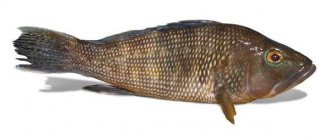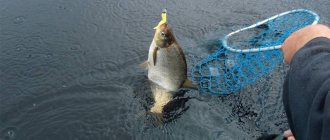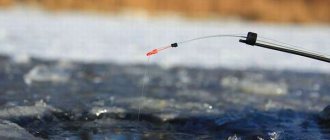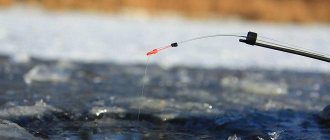As soon as the reservoirs are covered with a crust of ice, a whole army of winter extreme connoisseurs immediately appears - fishermen, tourists, those who like to slide down the mountainous river bank on a sled, or those who want to turn part of the river or pond into an ice skating rink. Motorists are also on the alert, finally they don’t have to get to the nearest bridge or crossing, because there is an ice road! Residents of lake and river areas arrange pedestrian and automobile crossings to shorten the path to their destination.
How can you determine whether it is safe to walk, drive, or skate on ice? You should not take risks, endangering yourself and your comrades: for each of these cases there are special rules. If you have children, be sure to teach them what thickness of first ice is safe. It is easier to prevent an accident than to save someone who is caught on fragile ice!
For man
Experienced hunters and fishermen can recognize the approximate thickness of ice by its color. Blueish or “green” ice is considered durable, and the more transparent the ice covering, the stronger it is. A matte white or yellowish color indicates unreliability. If you see a section of a river under ice with no traces of animals or humans, think about why this is. Most likely this is the place where the springs flow; the ice crust there is very thin, and because of the snow it is not visible.
Safe Ice Thickness
This you need to know:
- Ice that is at least 10 cm thick in fresh water and 15 cm in salt water is considered safe for humans.
- At river mouths and channels, the ice strength is weakened.
- Ice is fragile in places of fast currents, gushing springs and runoff water, as well as in areas where aquatic vegetation grows, near trees, bushes, and reeds.
- If the air temperature remains above 0 degrees for more than three days, then the ice strength decreases by 25%.
Let's consolidate the material about the strength of ice:
- blue ice is durable,
- white - its strength is 2 times less,
- dull white or with a yellowish tint - unreliable.
Don't take winter walks lightly and don't prepare in advance. It is very difficult for someone who has fallen through the ice to get out, since the edges of the hole will break off under its weight. An adult or child can drown from hypothermia, which sets in after a quarter of an hour. Some people experience cold shock.
We recommend that you read the article: Thin ice and its dangers.
Minimum ice thickness for pedestrian crossing
You can download a memo about safety and rules of behavior on ice after the article.
What thickness of ice can support the average weight of a person, approximately 70 kg?
What thickness of ice can support the average weight of a person, approximately 70 kg?
It all depends on how the ice was formed. The safest ice is ice that is clear and formed without snow or wind. The most dangerous ice is that formed with water and snow. For an average person weighing 70 kg, ice 7 cm thick is safe.
This is quite a pressing issue in winter, since sometimes in winter you have to cross a river on ice, this is a pressing issue for fishermen.
So, in order to go out on the ice in winter, you must know the thickness of the ice. It is believed that a person can go out on the ice if the ice thickness is more than seven centimeters . If we talk about fishing, it is recommended to go out on the ice when its thickness is more than 10 centimeters. Many people already begin to go out on the ice when its thickness is about five centimeters, but this is not entirely safe.
If we talk about passenger cars, they can drive onto the ice if its thickness is more than twenty centimeters.
So it will be safe for a person weighing 70 kilograms to go out on the ice if its thickness is 7 cm.
A very pressing question just before the onset of winter. Experienced fishermen are able, for example, to recognize the thickness of ice by its color. Strong ice is blue or greenish, and the more transparent it is, the stronger it is, but white ice or yellowish ice is still fragile and unreliable. The safest ice thickness for humans is considered to be at least 10 centimeters thick, if we are talking about fresh water, and in salt water it should be at least 15 centimeters thick. The Ministry of Emergency Situations generally talks about 12 centimeters, not 10.
It is believed that if the ice thickness is 7 centimeters or more, then it is already possible to walk on it, but up to 7 centimeters is dangerous. According to the Ministry of Emergency Situations, it is safe when the ice thickness is 12 centimeters.
For winter crossing
We present the data in the table below.
| Safe thickness, m | Taking into account weight, t | Taking into account the distance to the ice edge, m | |
| where there is fresh water | where there is sea water | ||
| 0,10 | 0,15 | up to 0.1 | 5 |
| 0,20 | 0,25 | up to 0.8 | 10 |
| 0,25 | 0,30 | up to 3.0 | 20 |
| 0,35 | 0,45 | up to 6.5 | 25 |
| 0,40 | 0,50 | to 10 | 26 |
Knowing the weight of the equipment, it is not difficult to calculate what the ice should be like.
Safe ice
What kind of ice can you go fishing on? Officially, the permissible ice thickness for a group of people to move on it must be at least 10 cm while fishing. This is depicted on safety posters. The minimum ice thickness for fishing is 3-5 cm, depending on the reservoir, at your own peril and risk
You need to walk on this very carefully, according to all the rules (more on this below). It is not recommended to go to depths greater than 1.5 meters and far from the shore
10 cm can support a person weighing 100 kg and allow the movement of a group of people
10 cm can support a person weighing 100 kg and allows the movement of a group of people.
Ice thickness table for safe movement:
At what temperature does ice form on a body of water?
The durable surface is usually transparent, with a bluish or greenish tint. Turbidity, bubbles, yellowness are signs of a fragile ice shell. A good layer freezes in calm frosty weather. The freezing layer can be covered with snow, which will stick together with water into a single white mass. Such a surface is fragile and fragile.
Safety on poor ice cover
Anglers are looking forward to the moment of first ice formation. The most desperate ones go out onto the ice as soon as it becomes available, neglecting safety requirements. The first ice is dangerous, first of all, due to its small thickness. The official rule of behavior on thin ice is one thing - do not go on it. If you find yourself in such conditions, you must strictly follow all safety and behavior recommendations.
It is impossible to determine the thickness of the ice by color based on the first ice - it is thin and transparent. If an ice pick breaks through with one blow, it is better not to go far from the shore, but to sit next to the coastal bushes. At depth, the ice strengthens later, so going out into the middle of the reservoir is dangerous. Safety on thin ice cover is the first priority of a fisherman who finds himself on a body of water in such conditions. Every second you need to be internally ready to go under water, and react confidently and quickly. The condition of the ice layer on different reservoirs may vary due to many factors - the strength of the current, wind, water composition, and the presence of springs. Therefore, good cover on that pond over there is not a reason to go out to the large reservoir, where waves were flowing just yesterday.
How to move on thin ice if it begins to crack and sag? First of all, stop and look around. If sagging occurs right before your eyes, you need to immediately lie down, as softly and smoothly as possible, without hitting the surface with weight. Then you need to crawl back in your footsteps. If everything is not so fatal, you just need to retrace your steps with smooth sliding steps, without lifting your feet. In general, it is better to stick to the beaten path and always walk on them. Potentially hazardous places:
- The middle of a reservoir, great depths, channel flow.
- Junction points of forward and reverse flows.
- Mouths of rivers and streams.
- Directly by the shore.
- In the thickets of reeds.
- Near objects frozen in water.
- Sewage and waste disposal areas.
- Narrow channels with currents, rapids between islands.
- At edges and gullies.
- Water areas with frequent changes in water level and shipping traffic. Such a place can play a cruel joke - the fisherman will simply be cut off from the exit by a passing vessel, torn off from the main body of ice on an ice floe and carried out to sea.
- Swamps and bogs are the most dangerous places. The warm gas released can make the apparently normal and hard integument weak and thin.
For technology
| Safe thickness, m | Taking into account weight, t | Taking into account the distance to the ice edge, m | |
| where there is fresh water | where there is sea water | ||
| 0,70 | 0,55 | up to 20 | 30 |
| 100 | 0,95 | up to 40 | 40 |
When organizing a crossing for equipment, the following factors are taken into account:
- depth of the reservoir;
- current speed;
- the distance between the banks of the river;
- intensity of cargo traffic;
- when a hydroelectric power station is located nearby, the route calculation data is compared with the operating mode of the hydroelectric power station.
Ice crossing by car
Theory and practice
The ice track is cleared of snow on both sides of the axis (at least 10 m) and marked with milestones (every 15-20 m). Since the traffic on the highway is one-way, the road with reverse traffic should be laid at least 100 m apart. The thickness of the ice is measured by punching holes 5 m apart (near the coast the distance is reduced to 3 m), the diameter of the holes is from 6 to 10 cm. The holes are located according to the principle of chess squares at a distance of 5 m from the axis in both directions. For safety, they are fenced with a snow embankment around the circumference and covered with wooden shields. Any “hanging” ice that occurs is broken down mechanically. Measurements are taken by the local hydrometeorological service every 5 days, and more often in case of thaws.
In addition to the weight of the equipment, adjustments are made for traffic intensity using the formula:
Htr = na P
It takes into account:
- H – ice thickness;
- n – traffic intensity coefficient (with a traffic volume of 500 vehicles per day, n is equal to 1, if 1 is 500, then 400 is 0.8, etc.);
- a – load characteristic indicator (wheeled, tracked);
- P – load mass, i.e.
The formula can be supplemented depending on local conditions.
As you can see, it is much easier to secure the movement of one person, but only if this person follows the rules. Ultimately, the table of permissible ice thickness (and load on it) when organizing the crossing of equipment will look like this:
| Permissible load, t | Required ice cover thickness (cm), taking into account the average daily t for the past 3 days | Distance between cars, m | ||
| – 10 ° and below | – 5 °C | With a short-term thaw to 0 ° | ||
| Tracked vehicles | ||||
| 4 | 18 | 20 | 28 | 10 |
| 6 | 22 | 24 | 31 | 15 |
| 10 | 28 | 31 | 39 | 20 |
| 16 | 36 | 40 | 50 | 25 |
| 20 | 40 | 44 | 56 | 30 |
| 30 | 49 | 54 | 68 | 35 |
| 40 | 57 | 63 | 80 | 40 |
| 50 | 63 | 70 | 88 | 55 |
| 60 | 70 | 77 | 98 | 70 |
| Wheeled vehicles | ||||
| 3,5 | 22 | 24 | 31 | 18 |
| 6 | 29 | 32 | 40 | 20 |
| 8 | 34 | 37 | 48 | 22 |
| 10 | 38 | 42 | 53 | 25 |
| 15 | 46 | 50 | 64 | 30 |
Time of ice formation in Russia
Most of the regions in the Russian Federation are located in latitudes with a cold climate, where winter lasts more than 3 standard months. The first ice capable of supporting the weight of a person appears on reservoirs by the end of November. Coverage suitable for vehicle movement is formed only in mid-January. At the same time, the weather for the entire previous period is taken into account. When the ambient temperature remains within 0 degrees for 3 days, the strength decreases by a quarter of the original value.
Officially, ice crossings across reservoirs begin to function in mid-January. They close at the end of February, provided there are no short-term thaws in winter
It is important to remember that the timing of ice formation varies depending on the region. Therefore, you must first find out the weather forecast and official statements from the authorities regarding the thickness of the ice cover
Amendments and clarifications
When using the table, it should be taken into account that the average daily temperature and “ideal” conditions for the formation of the “freshwater shellfish” type of ice are taken. The thickness of porous ice will have to be doubled. If there is salt water in the reservoir, the correction factor is reduced to 1.2. With frequent thaws, the carrying capacity of each piece of equipment is determined practically.
If necessary, the ice cover is thickened artificially by clearing the space, pouring water on it and waiting for the layers to freeze. If it is necessary to transport equipment to the site of diving work in places where ice covers sea bodies, the conditions change as set out in the first table of the article.
But let us return once again to the requirements of behavior in winter on a river or pond, valid for a person, and especially for children, who are more often than adults, unreasonable. It is believed that ice for a person to be safe on it must be at least 10-15 cm (depending on the water - fresh or salt). In the case of mass events on ice, the norm increases to 25 cm. You should also know how to behave if someone (or yourself) falls through the ice, because panic can lead to a sad outcome.
Rules of conduct on thin ice
Safe ice
Permissible and safe thickness of ice when moving on it.
What kind of ice can you go fishing on? Officially, the permissible ice thickness for a group of people to move on it must be at least 10 cm while fishing. This is depicted on safety posters. The minimum ice thickness for fishing is 3-5 cm, depending on the reservoir, at your own peril and risk
You need to walk on this very carefully, according to all the rules (more on this below). It is not recommended to go to depths greater than 1.5 meters and far from the shore. 10 cm can support a person weighing 100 kg and allow the movement of a group of people
10 cm can support a person weighing 100 kg and allows the movement of a group of people.
Ice thickness table for safe movement:
At what temperature does ice form on a body of water?
The durable surface is usually transparent, with a bluish or greenish tint. Turbidity, bubbles, yellowness are signs of a fragile ice shell. A good layer freezes in calm frosty weather. The freezing layer can be covered with snow, which will stick together with water into a single white mass. Such a surface is fragile and fragile.
Safety on poor ice cover
Anglers are looking forward to the moment of first ice formation. The most desperate ones go out onto the ice as soon as it becomes available, neglecting safety requirements. The first ice is dangerous, first of all, due to its small thickness. The official rule of behavior on thin ice is one thing - do not go on it. If you find yourself in such conditions, you must strictly follow all safety and behavior recommendations.
It is impossible to determine the thickness of the ice by color based on the first ice - it is thin and transparent. If an ice pick breaks through with one blow, it is better not to go far from the shore, but to sit next to the coastal bushes. At depth, the ice strengthens later, so going out into the middle of the reservoir is dangerous. Safety on thin ice cover is the first priority of a fisherman who finds himself on a body of water in such conditions. Every second you need to be internally ready to go under water, and react confidently and quickly. The condition of the ice layer on different reservoirs may vary due to many factors - the strength of the current, wind, water composition, and the presence of springs. Therefore, good cover on that pond over there is not a reason to go out to the large reservoir, where waves were flowing just yesterday.
How to move on thin ice if it begins to crack and sag? First of all, stop and look around. If sagging occurs right before your eyes, you need to immediately lie down, as softly and smoothly as possible, without hitting the surface with weight. Then you need to crawl back in your footsteps. If everything is not so fatal, you just need to retrace your steps with smooth sliding steps, without lifting your feet. In general, it is better to stick to the beaten path and always walk on them. Potentially hazardous places:
- The middle of a reservoir, great depths, channel flow.
- Junction points of forward and reverse flows.
- Mouths of rivers and streams.
- Directly by the shore.
- In the thickets of reeds.
- Near objects frozen in water.
- Sewage and waste disposal areas.
- Narrow channels with currents, rapids between islands.
- At edges and gullies.
- Water areas with frequent changes in water level and shipping traffic. Such a place can play a cruel joke - the fisherman will simply be cut off from the exit by a passing vessel, torn off from the main body of ice on an ice floe and carried out to sea.
- Swamps and bogs are the most dangerous places. The warm gas released can make the apparently normal and hard integument weak and thin.
Avoid first ice covered with snow - it may just be crust, and underneath it there may be a gulley. In a group you should not come close to each other or gather together. You need to move in single file, no closer than 5-7 meters from each other. Each person should have a special life preserver on a rope, attached conveniently to the chest for quick use. It is advisable to have a rope with a load so that you can quickly throw it to someone who has failed. You cannot drill many holes at once - such perforation will weaken the already unreliable surface.
Rules of conduct on thin ice
When the seemingly strong ice for safe movement is replaced by porous and brittle, you may suddenly find yourself in the water, pull yourself together and follow the recommendations:
- Spread your arms to the sides so that you can lean on them without breaking the edges of the “font” and not choking.
- You will have to crawl out of the hole, avoiding impetuous movements. If you have ice awls and a rope, use them to pull yourself up.
- The basic rule: do not rely on individual areas of a small area, but try to position yourself so that the largest possible area serves as support.
- Roll away from the edges of the hole, and when you get to your feet, do not run, move slowly and without raising your feet above the ice surface.
- When helping someone who has fallen through, find something that will help expand the support area (sports equipment, plywood, plastic).
- Do not stand on the edge of the hole, act at the optimal distance.
- Throw a rope to the person caught in the hole and pull with even movements, helping to get out.
- When you get home, change the victim’s clothes, give him tea (without added alcohol!) and call an ambulance.
Behavior rules
Rescuers operating in conditions where movement on ice is required must remember:
- When choosing a route, you need to remember about drifting ice (on the sea, lake), find out the speed and direction of the current and wind.
- It is worth stocking up on anti-slip devices.
- On water with currents, the thickness of the ice can be different everywhere.
- In swamps, unlike rivers, the ice is stronger in the center and weaker at the edges.
Video about the rules of being on ice
Rules for moving on frozen bodies of water
The best way to protect yourself is to not go on the ice at all, but this is not always possible. Sometimes circumstances force us to go on such a walk, and sometimes it’s just the usual desire to go fishing. Is it possible to deny your passion for fishing?
When warm weather persists for a long time, the ice becomes less dense and, accordingly, its fragility increases, regardless of its thickness.
It is imperative to follow all safety measures.
Let's look at a few mandatory rules:
- Determine the color of the ice surface; the higher the turbidity, the more dangerous the transition will be;
- Never cross the surface of a frozen body of water at night or in conditions of poor visibility. The likelihood of anyone seeing you when you fail is zero;
- Use official ice crossings if available. There are always a lot of people there;
- If there are several of you, then you need to walk on the ice in a group, keeping a distance of 5-6 meters from each other;
- To easily cross the ice you can use skis. You need to ski with the bindings unfastened and the poles held freely in your hands. A person wearing skis creates less pressure on the ice surface than a person without skis;
- If you have any burden with you, hold it so that if something happens (falling through the ice) you can quickly get rid of it;
- You can take a rope with a large loop at one end and a weight at the other. Thanks to the heavy weight, which creates little pressure on the surface of the ice, you can easily get out from under the ice if you fall through.
- If you go fishing, you need to stop where there are a lot of fishermen. You should not drink alcohol while fishing.
- If the temperature begins to rise, it is better to cancel fishing or walking on a frozen body of water. You can sit out the period of rising air temperatures at home.
E
then there are a few simple rules that will help you if you cross a frozen body of water and, perhaps, save your life. Never go out on a frozen surface while intoxicated, which often happens when fishing. Don't let your children play in the water without your supervision. Be careful and value your life and the lives of your loved ones.
Voiced specifically for Rarog Survival
Some fishermen, after the end of the summer fishing season, switch to the winter season. Despite the fact that ice fishing has its own specifics, it brings no less pleasure than summer fishing. The only thing is that fishing on ice requires some safety measures from the fisherman, since very disastrous consequences are possible.
In this case, everything is related to the thickness of the ice. If you do not take into account the thickness of the ice, you can easily fall through the ice and then drown, which happens quite often. Sometimes anglers drive cars onto the ice, after which both the fishermen and their cars have to be pulled out.
Rules of conduct on a frozen pond
- Do not experiment with testing the strength of the cover with your feet; take a pole with you.
- Find existing, well-trodden paths.
- If you are one of the first to build such a walking trail, test the strength of the ice in front of you with a stick, and avoid places that do not inspire confidence.
- Remember the signs of a fragile coating: cracking, mobility, the appearance of water above the surface. If this happens, move away from this place with your feet wider, slowly, or even crawling.
- You cannot move in a group (there should be a gap of at least 5 meters between travelers or skiers), with skis fastened to your feet, and with ski poles attached to your hands.
- Fishermen need to calculate the number of holes in a certain area and drill them at a considerable distance from each other.
- If you have a load (satchel, backpack), it is better to secure it with a rope and drag it at a distance.
- If there is a need to overcome a section of fragile ice, go there with a belayer. Even moving at a distance of 5 meters, he will provide assistance in the event of an accident.
- If you have the opportunity, it is best to drill a hole and measure the thickness of the ice before your winter hike.
- It is not recommended to fish near melted or damaged areas of ice.
- Stock up on twelve meter (or longer) rope, there should be a load at one end.
Test of strength
When you arrive fishing, the first thing you should do is check the surface for strength. It is very important! If it turns out to be thin, the ice will crack and the person will fall into the water. Test of strength:
You need to know that it is easy to fall into the water if you test your strength with a kick. Therefore, under no circumstances should this be done. You can determine that the surface is fragile and should not be accessed by the following signs:
Today you can find out the strength and thickness of ice for fishing on a large body of water from the forecast of the Ministry of Emergency Situations, which are regularly published.











